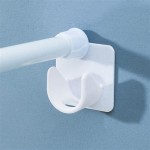Mini Curtains: Optimal Window Treatments for Small Spaces
Small windows, often found in bathrooms, kitchens, hallways, and even some smaller bedrooms, present unique challenges when it comes to window treatments. Standard-sized curtains can overwhelm the space, blocking too much light and detracting from the overall aesthetic. This necessitates the consideration of mini curtains, a category of window coverings specifically designed for smaller window dimensions. Mini curtains offer a practical and aesthetically pleasing solution, providing privacy, light control, and visual appeal without overpowering the space.
The term "mini curtains" encompasses a variety of styles and materials, each offering distinct advantages. These include, but are not limited to, cafe curtains, tier curtains, valances, and specialized blinds or shades designed for narrow window frames. The key consideration when selecting mini curtains is the specific function they need to serve, as well as the overall design scheme of the room.
The selection process should account for several factors, including the desired level of privacy, the amount of natural light required, and the existing color palette and decor. The purpose of this article is to explore the various types of mini curtains available, the benefits they offer, and the key considerations for choosing the right window treatment for small windows.
Types of Mini Curtains
The world of mini curtains extends beyond a single style, offering diverse options to suit varying needs and aesthetic preferences. Understanding these options is crucial for making an informed decision.
Cafe Curtains: These curtains typically cover the lower portion of the window, allowing natural light to filter through the top while providing privacy at eye level. Cafe curtains are a popular choice for kitchens and bathrooms, often hung on tension rods or small curtain rods. They are available in a wide range of fabrics, patterns, and colors, making them a versatile option for various decor styles. Their design allows for both privacy and ample light, making them ideal for spaces where complete blockage is not desired.
Tier Curtains: Similar to cafe curtains, tier curtains are often used in pairs and cover either the top or bottom half of the window, or both, creating a layered effect. This style is popular for adding a touch of charm and visual interest to smaller windows. The use of different fabrics or patterns for the top and bottom tiers can create a unique and personalized look. They offer flexibility in light and privacy control, depending on the placement and opacity of the fabric chosen.
Valances: Valances are short, decorative curtains that hang across the top of the window, often used in conjunction with other window treatments like blinds or shades. They add a touch of elegance and can conceal hardware or imperfections around the window frame. Valances come in a variety of styles, including gathered, pleated, and shaped designs, and can be made from various fabrics. They contribute to the overall aesthetic of the room without significantly blocking light.
Mini Blinds and Shades: Although not technically "curtains," mini blinds and shades are specifically designed for small windows and offer excellent light control and privacy. Mini blinds consist of horizontal slats that can be tilted to adjust the amount of light entering the room. Shades, such as roller shades or cellular shades, provide a more streamlined look and can be raised or lowered to control light and privacy. These options are available in a variety of materials, including vinyl, aluminum, and fabric, providing versatility in both style and functionality.
Beyond these common types, customized solutions can also be explored. A tailor can adjust standard curtains to fit smaller window dimensions, creating a more personalized solution with specific fabric choices and design elements.
Benefits of Using Mini Curtains
Choosing mini curtains provides numerous advantages over using standard-sized curtains on small windows. These benefits extend beyond mere aesthetics and encompass practical considerations regarding space, light, and functionality.
Space Optimization: The primary benefit of mini curtains is their ability to optimize space in small rooms. Standard-sized curtains can overwhelm the limited space around a small window, making the room feel cramped. Mini curtains, designed to fit the window's dimensions, avoid this issue, allowing for more usable space and a more balanced visual appeal.
Enhanced Light Control: Mini curtains offer effective light control, allowing one to adjust the amount of natural light entering the room. Options like mini blinds and roller shades provide precise control, while cafe and tier curtains allow for filtered light while maintaining privacy. The ability to control the amount of light is crucial for creating a comfortable and functional environment, especially in rooms like bedrooms and offices.
Improved Privacy: Privacy is a key consideration for window treatments, particularly in bathrooms and bedrooms. Mini curtains effectively block unwanted views from outside, providing a sense of security and seclusion. The level of privacy achieved depends on the fabric's opacity and the style of the curtain. Thicker fabrics and features such as blackout linings offer greater privacy, while sheer fabrics provide filtered light and a degree of privacy.
Aesthetic Appeal: Mini curtains can significantly enhance the aesthetic appeal of a room. They add a touch of style and personality to the window area, complementing the overall decor. With a vast selection of colors, patterns, and textures available, mini curtains can be chosen to match or contrast with the existing color scheme, creating a cohesive and visually pleasing look. They can also add a decorative element to an otherwise plain window, enhancing the room's overall atmosphere.
Cost-Effectiveness: Generally, mini curtains tend to be more cost-effective than larger, custom-made window treatments. Due to the smaller fabric requirements and simpler designs, mini curtains often represent a more budget-friendly option for homeowners looking to enhance their small windows.
Key Considerations When Choosing Mini Curtains
Selecting the right mini curtains for a small window involves careful consideration of several factors. These factors relate to functionality, aesthetics, and the specific needs of the room in question.
Window Size and Shape: The most crucial factor is the accurate measurement of the window. Mini curtains should be sized precisely to fit the window frame, avoiding an ill-fitting or oversized appearance. The shape of the window also plays a role; arched or unusually shaped windows may require custom-made solutions. Precise measurements ensure a clean and professional look.
Privacy Requirements: The desired level of privacy will dictate the type of fabric and style of mini curtain to choose. If complete privacy is needed, consider blackout fabrics or tightly woven materials. For areas where filtered light and a degree of privacy are sufficient, sheer or semi-sheer fabrics may be more appropriate. The placement of the window (e.g., facing a street or neighboring building) will also influence privacy needs.
Light Control Needs: The amount of natural light desired in the room is another important consideration. Options like mini blinds and roller shades offer precise light control, allowing for adjustment based on time of day and personal preference. Cafe and tier curtains provide diffused light, creating a softer and more ambient atmosphere. The direction the window faces will also influence light control needs, as south-facing windows tend to receive the most sunlight.
Decor Style and Color Scheme: The mini curtains should complement the existing decor style and color scheme of the room. Consider the overall aesthetic – whether it is modern, traditional, bohemian, or minimalist – and choose curtains that align with that style. The color of the curtains should either match or contrast with the walls and furniture, creating a cohesive and visually appealing look. Patterns and textures can also add visual interest, but should be chosen carefully to avoid overwhelming the space.
Maintenance and Cleaning: The ease of maintenance and cleaning should also be considered. Certain fabrics may require more frequent cleaning or specialized care. Mini blinds can collect dust and may require regular cleaning with a duster or damp cloth. Fabric curtains can be machine-washed or dry-cleaned, depending on the material. Choosing a low-maintenance option can save time and effort in the long run.
By carefully considering these factors, one can select mini curtains that not only fit the window perfectly but also enhance the overall functionality and aesthetic appeal of the room. The goal is to create a space that is both comfortable and visually pleasing, with window treatments that complement the existing decor and provide the desired level of privacy and light control.

13 Charming Curtain Ideas For Small Windows

Curtain Solutions For Small Windows Beth Bryan

Window Treatments For Small High Windows A Design Dilemma Cate Holcombe Interiors

Mini Window Curtains For Small Windows Blackout Sheer Options

Window Treatments For Small High Windows A Design Dilemma Cate Holcombe Interiors

Beige Kitchen Tier Curtains 30 Inches Long Linen Textured Cafe Short Bathroom Privacy Small Mini Half Window Curtain Basement 2 Panels Grommet Top Wal Com

Valance Curtains Kitchen Short Small Mini Living Room 18 Inches Long Linen Textu

Pale Purple Kitchen Tier Curtains 30 Inches Long Linen Textured Cafe Short Bathroom Privacy Small Mini Half Window Curtain Basement 2 Panels Grommet Top Wal Com

Small Window Panels

Sky Blue Kitchen Tier Curtains 24 Inches Long Linen Textured Cafe Short Bathroom Privacy Small Mini Half Window Curtain Basement 2 Panels Grommet Top Wal Com








